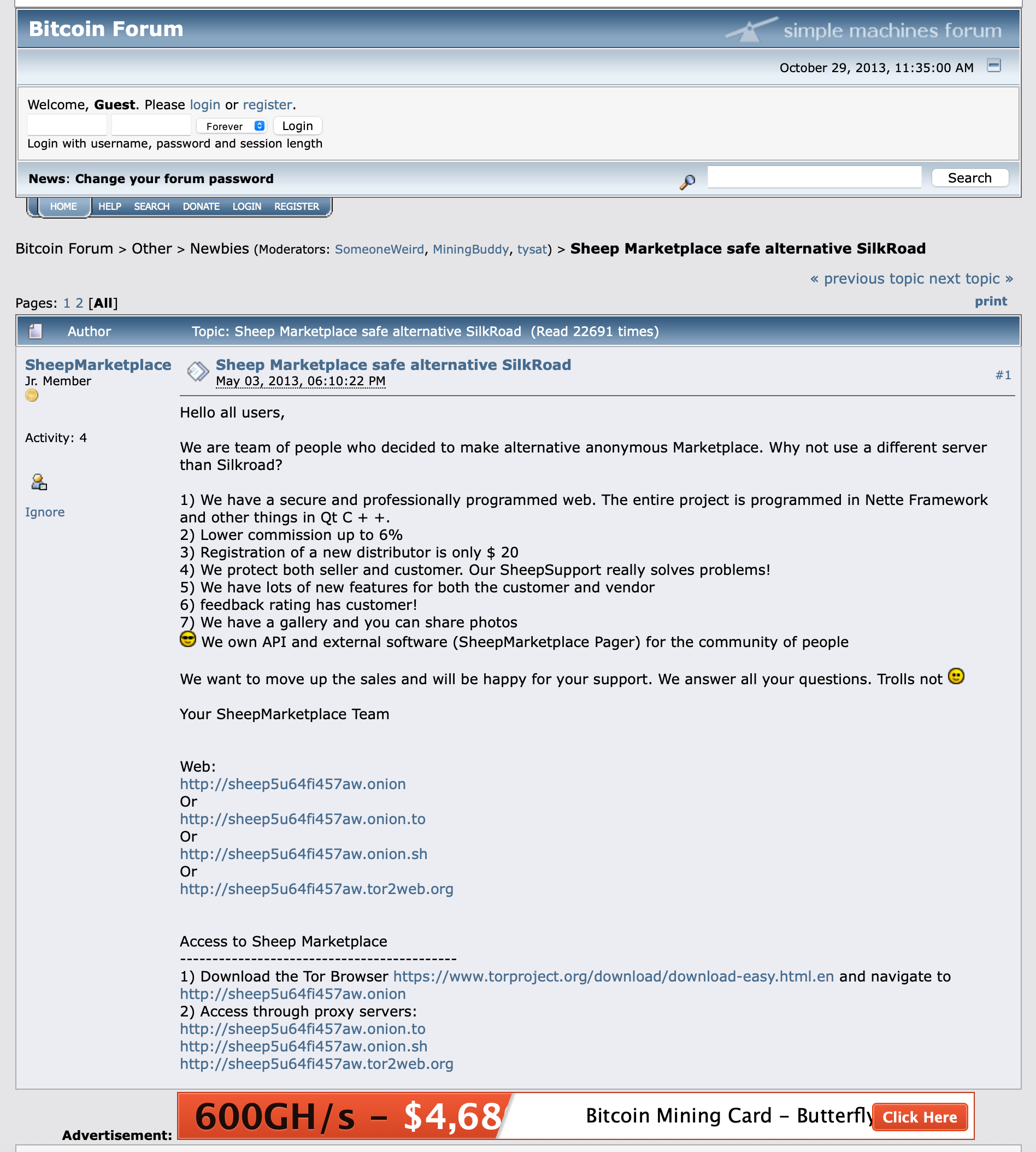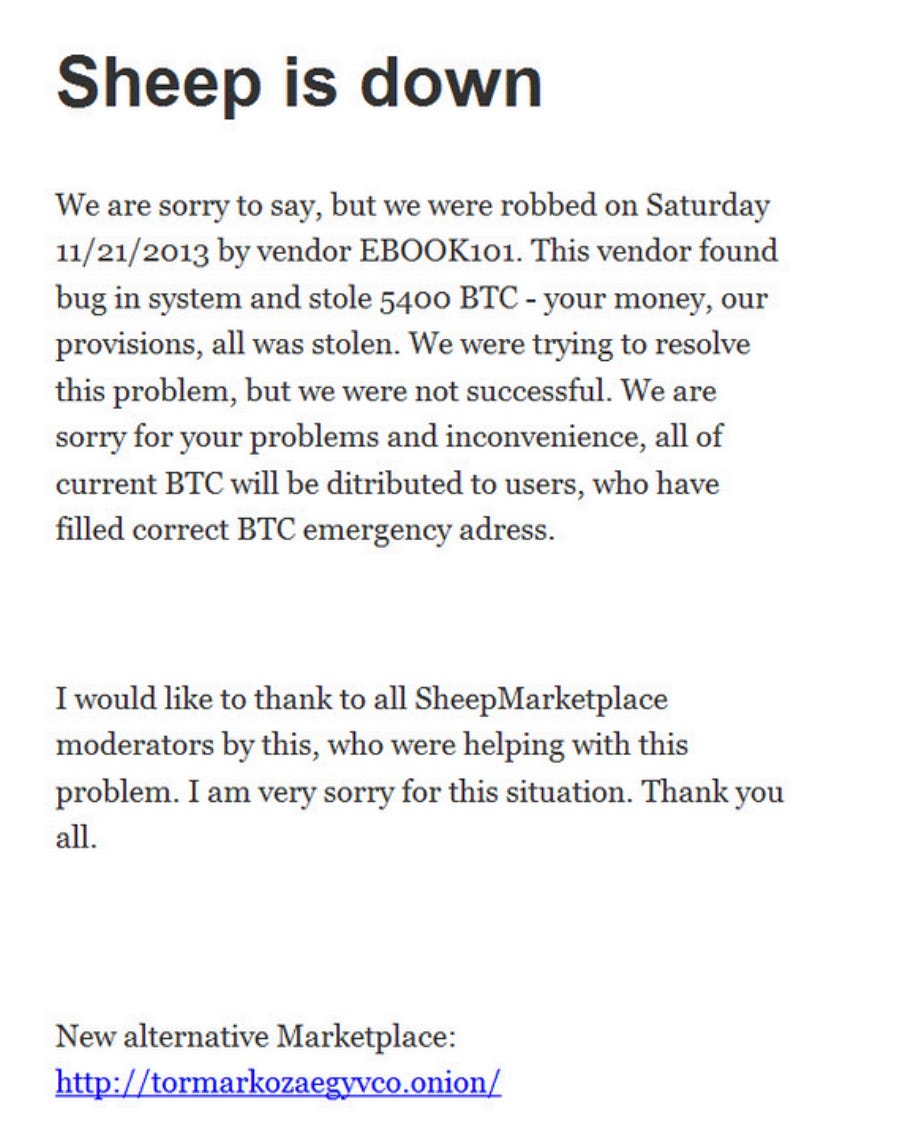If you don’t live in the Czech Republic, you may not understand this story. A few years ago, when the government wanted to promote tourism in the Czech Republic, it came up with the slogan “land of stories.” The Czech Republic is truly a land of stories. This story is about how a former locksmith created a marketplace serving drug cartels and arms dealers, then disappeared with 5,000 bitcoins and ended up in prison for a few years. And when it seemed that no one wanted him anymore, he offered the Ministry of Justice a gift worth 468 BTC. Just like that. The minister accepted the gift because it was “crystal clear.” Only to find out the next day that it came from the “exit scam” of one of the largest illegal marketplaces, Nucleus Market.
Do you think I made this story up? I wish I were such a good storyteller. Let’s retell it together and put it into context.
Sheep Marketplace
To begin Jiřikovský’s venture into cryptocurrencies, let’s look back to 2011, when the “online marketplace” Silk Road was founded, operating on the “dark web” via the anonymous TOR network.
On Silk Road, you could offer and buy anything, but given the anonymity of both parties and the anonymity of payments via cryptocurrencies (at that time, Bitcoin), the items sold there were mainly things you wouldn’t want to ask for at a corner store. That is, weapons, drugs, stolen data, and often illegal work of all kinds. The Silk Road marketplace ceased operations in 2013 when the FBI arrested its founder, Ross Ulbricht, after identifying him. Incidentally, Ross Ulbricht, who was sentenced to life imprisonment, was pardoned and released by President Trump in January 2025.
The Silk Road case highlighted the potential of such intermediary marketplaces. And so, followers soon appeared on the dark web, in the dark depths of the internet accessible only to “insiders,” but not to Google. In May 2013, even before Ulbricht’s arrest in October 2013, an advertisement promoting Sheep Marketplace was published on the Bitcoin Forum.

The post is written in beginner’s English, but linguists later conclude that it contains errors typical of Slavic languages (missing articles, Slavic word order, problems with prepositions, etc.)—and it also mentions the Czech framework Nette.
Sheep Marketplace gradually grew, gaining the biggest boost in October 2013 when Silk Road was shut down. It is essentially a simple discussion forum where supply and demand are matched, buyers deposit their bitcoins in escrow on the marketplace, and if the transaction is settled to the satisfaction of both parties, the marketplace transfers the funds, retaining a commission.
Everything worked well until November 21, 2013, when a user named EBOOK101 discovered a flaw in the marketplace. This flaw allowed EBOOK101 to repeatedly withdraw Bitcoins from the escrow account without the system properly verifying that the funds had actually been released and the transaction completed. As a result, he was able to transfer far more Bitcoins than he was actually entitled to, draining tens of thousands of BTC from the marketplace. The marketplace subsequently closed money transfers from escrow and shut down completely on December 2, 2013. Its (as yet unknown) operator melted into the role of the victim.

The initial theft of 5,400 Bitcoins was resolved in 2014. The FBI monitored the wallets to which the funds were transferred, and when the funds were transferred to the popular exchange Coinbase, the thieves were identified as Nathan Gibson and Sean Mackert. At the time, they were 24 and 21 years old. They faced 20 years in prison, but I was unable to find out what happened to them. In 2020, they appealed, arguing that they were not “traditional criminals.” The funds and assets that the FBI managed to track down were seized, but many accounts remain “dormant” wallets with no activity for many years.
Jiříkovský is a suspect
On discussion forums, especially on Reddit, users are conducting their own “investigation” of cryptocurrency users, and suspicion has fallen on Tomáš Jiříkovský for a number of reasons. The Czech police are quickly investigating these suspicions—there is a lot of circumstantial evidence, which is enough for the community to be “certain,” but not enough for the Czech courts. A house search in February 2014 found nothing that would allow Jiříkovský to be charged, so the police returned all the confiscated items to him. He then began looking for a new house and eventually reserved one in Lužice near Hodonín in the name of his grandfather (a professor at Masaryk University) and tried to buy it with money converted from bitcoins into a new account belonging to his wife Eva Jiříkovská. However, the purchase drags on because converting almost CZK 9 million ($400,000) of the purchase price into legal tender is not so easy. In March 2015, he is detained in connection with money transfers that the FAU has deemed suspicious. However, he is released within 48 hours. Once again, the police believe that there is insufficient evidence to stand up in court. But they do not let him out of their sights.
Over the next twelve months, Jiříkovský moved and partially cashed in his bitcoins, financed real estate (eventually buying it in a friend’s name), and, according to technical evidence, participated in the launch of another marketplace, which will be discussed later.
On April 12, 2016, he was arrested by the NCOZ, and another wave of searches and seizures of electronic equipment followed, some of which could not be decrypted, but others were clear evidence, such as an unencrypted database of Sheep Marketplace user accounts. It was this long-term surveillance that broke Vaz. Extended analytical monitoring of the blockchain (NCOZ + Europol “Trace Chain”) revealed a link to a cluster of approximately 40,000 BTC withdrawn during the Sheep Marketplace exit scam. This is no longer an explainable valuation of mined bitcoin, but illegal activity.
A year later, the High Court in Olomouc sentenced him to 9 years for embezzlement of BTC, drug trafficking, and illegal possession of weapons.
A billion-dollar gift with no strings attached?
When he is conditionally released in 2021 after serving half of his sentence, another game begins. The return of electronics, including a laptop with a bitcoin wallet. Jiříkovský did not have all his seeds backed up on paper, and the largest amounts were reportedly stored on an encrypted disk that could not be decrypted or on a Trezor. Initially, the courts refused to release the electronics, but later they allowed it and even prohibited the deletion of the contents. In January 2025, a decision was made and the undeleted electronics were to be returned to Jiříkovský.
And then we are once again left with only Minister Blažek’s version, according to which contact was made through a lawyer with the Ministry of Justice, which received an offer of a donation of 30% of the bitcoins from the wallets on the confiscated electronics. We can think what we want about it, but that is how the whole thing allegedly took place, and with the participation of an expert, a lawyer, and the deputy minister of justice, the electronics were revived on March 7, 2025, and the Ministry of Justice’s share was set at 468 BTC. It was then transferred.
Media storyline…
The ministry did not rush to spend the bitcoins it received. It converted them into Czech koruna using the standard procedure in cooperation with the UZSVM in an electronic auction in packages of 5 BTC from the end of March until 8 a.m. on May 27, 2025, when the last tranche was sold. The event was uncovered that same day by Jakub Kopřiva from the Publico server, who was able to refer to the sales contracts that began to appear in the contract register (here Hlídač státu).
Two hours later, Czech Television requested a statement and published the report on Twitter. And so the story began to smolder in the media.
On Wednesday morning, May 28, the Ministry of Justice invited journalists to a press conference on Thursday afternoon, where it wanted to boast about its billion-dollar income. However, another piece of the then unknown puzzle fell into place when Zdislava Pokorná from Deník N published an article on the evening before the press conference informing that the bitcoins came from a donation from the convicted Jiříkovský. At the same time, she pointed out that the National Center Against Organized Crime (NCOZ) was investigating the transaction on suspicion that it involved the legalization of money from criminal activity. Detectives had reportedly already come to the ministry building to collect documents.
This caused the event to explode in the media…
This is another moment worth pausing to consider. At that time, Deník N could not have had any public information about the origin of the money. The contracts in the Register and the auction show the amount, but not its origin. The information itself was not generally known at the Ministry of Justice; only a few people knew about it. How did Deník N find out this detail and why was this information disclosed to them?
Where was the catch? Too superficial…
Let’s now return to the course of the case, because so far everything was fine. Why would a controlled leak of information to the media change anything other than Minister Blažek being applauded a few hours earlier?
The whole thing had a few snags.
The complexity of the case can be better understood from the diagram prepared by Janusz Konieczny
The first is evidence (bitcoin movements can be tracked in the blockchain!) that the wallet had been tampered with the day before the BTC transfer to the UZSVM (Office for Government Representation in Property Affairs) and that transfers had already been made from it on March 6, 2025. This involved 546 BTC in several transfers to an address from which they were soon distributed further (including to the UZSVM). This may not mean anything, because according to Minister Blažek, it took about 30 hours to decode the wallets. Although this claim has been questioned, it may be entirely realistic, as the technology used in 2014-16 was Bitcoin Core, which required ten years of records to be downloaded and updated before the transfer. This could indeed have been a process that ran overnight and was only checked in the morning. This is also evidenced by the transfer times. At least for some of the technology, the commissioning was really lengthy, and since we do not know how many wallets were on what technology, other assumptions are unclear—among the confiscated (and released) items was reportedly a safe, which apparently refers to a Trezor digital wallet. It is entirely conceivable that the process took a long time and that Jiříkovský first started up one of the quickly recoverable wallets and intended to transfer the UZSVM money through another wallet so that it would not be clear which original wallet was involved. That was the cardinal problem.
The decrypted wallet is one of the wallets associated with Nucleus Marketplace. And that is the marketplace we were yet to discuss. The Nucleus Marketplace operated between 2014 and 2016, and there had been speculation that Tomáš Jiříkovský was its operator. However, there was no hard evidence, only community rumors, and officially, Jiříkovský had no connection to Nucleus. Perhaps the only thing that did connect them was that the marketplace was shut down the day after Jiříkovský’s arrest—and, of course, all the bitcoins in custody disappeared with it. There were supposed to be about 5,300 of them, worth around $400 million at today’s prices, which is the amount that iRozhlas will later be dealing with.
And this is the biggest stumbling block. Until now, it has been up to us whether we want to believe that Jiříkovský has reformed in prison and, with the plight of crime victims at heart, has decided to donate part of the bitcoins, which have increased in value during his imprisonment, to the Ministry of Justice. Just like that, for nothing. It could have happened, and we have no evidence to the contrary.
Except for this moment: Jiříkovský is suddenly manipulating assets directly related to the Nuclueus Marketplace exit scam. This directly links him to a crime for which he was not punished and to proceeds from criminal activity that should have been confiscated in their entirety.
A few things about the whole story don’t make any sense
Jiříkovský’s offer doesn’t make any sense. He had a court order for the release of his property, and all his electronic devices were returned to him on January 15, 2025. So why would he wait another two months to open his wallets, and why did he do so with people from the ministry? And why would he make such a gift when he didn’t have to? And again, why did the first transfers take place on March 6, while the next ones were not until March 7, when it was the same wallet? Why did he make the transfers when he must have been aware that at least the crypto community would be on the trail of the revived Nucleus wallet and doxx him, as Gwern did ten years ago?
On the other hand, why did Pavel Blažek take such a risk? While Tomáš Jiříkovský is not, to put it politely, the sharpest pencil in the box, Pavel Blažek is an experienced politician. Did his instincts fail him, drowned out by the desire for an interesting pre-election success? Did he really think that accepting a billion from a man of dubious reputation would just pass without notice? Or was it a situation from which there was no easy way out and anything he did would have been wrong? Or did he simply misjudge the technology behind Bitcoin and not know or realize how easy it is to trace?
Finally, one reservation must be acknowledged. The attribution of Jiříkovský’s bitcoin wallet to Nucleus Marketplace is not 100% certain. If it really was a coincidence and Jiříkovský was “laundering” his bitcoins in the mixer at the same time as the exit scam was taking place on Nucleus Market, his wallets could have been classified as suspicious using this technology. Of course, there is a lot of very good IT (i.e., not legal) evidence that Jiříkovský is the one who created and operated Nucleus, but he may not be the one who emptied it. However, I would say that this probability is less than 15%…
We don’t know much – will we ever find out?
We have to admit that there’s a lot we don’t know. And there are a lot of questions. It’s possible that an explanation involving corruption and dividing up bitcoins in exchange for a certain level of protection would answer a lot of questions. But it wouldn’t answer the main question: what motivation would Jiříkovský have had to make the donation? Did he really believe that involving the Ministry of Justice in the whole affair would legalize the money and at the same time conceal the fact that it came from accounts linked to Nucleus Market—and thus would not be confiscated as proceeds from criminal activity?
Or is it true that some fan of Pavel Blažek at the NCOZ, whose work the minister has not spoken very highly of, greased the wheels for him? All they had to do was release information in small doses and take advantage of the fact that the whole case has not been explained and still remains unexplained.
We don’t know. It will be interesting to follow.
Two people are in the greatest danger today: Tomáš Jiříkovský and Prime Minister Petr Fiala. Interesting rewards are being offered on crypto forums for information about Jiříkovský’s whereabouts by former members of Nucleus Market who, after many years, would like to obtain financial or at least moral satisfaction. By any means necessary.
And for Prime Minister Fiala, this case has the potential to cost him his job. If not now, then almost certainly in six months’ time.
Justice Minister Pavel Blažek resigned from his post on Friday.

